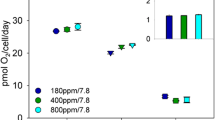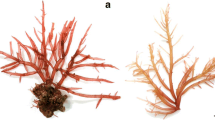Abstract
Intertidal macroalgae may spend a significant part of their lives in air. During photosynthesis in air, they encounter much lower concentrations of inorganic carbon than in seawater. Because they accumulate inorganic carbon from seawater, we investigated whether they similarly accumulate it from air. We measured photosynthesis in the intertidal species Fucus vesiculosus L. during 1990 and 1991 with a gas-phase O2 electrode or CO2-exchange apparatus in air and with a liquid-phase O2 electrode in seawater. Maximum rates were rapid and similar in air and seawater regardless of the method. Tissue from seawater could carry on photosynthesis in CO2-free air, indicating that carbon was stored in the tissue. After 2 h, this store was depleted and photosynthesis ceased. Supplying CO2 in air replenished the store. Under identical conditions, terrestrial C3 and C4 species showed no evidence of this store, but a CAM (crassulacean acid metabolism) species did. However, in contrast to the CAM behavior, F. vesiculosus did not store CO2 significantly in the dark. We found a small acid-releasable pool of carbon in the tissue that disappeared as photosynthesis depleted the carbon store. However, the pool was too small to account for the total carbon stored. While CO2 was being acquired or released from the store in the light, photosynthesis was not inhibited by 21% O2. These results indicate that there are two parallel paths for the supply of CO2 to photosynthesis. The first depends on inorganic carbon in seawater or in air and supports rapid photosynthesis. The second involves CO2 slowly released from an organic intermediate. The release protects CO2 fixation from the inhibitory effects of 21% O2. Photosynthesis in F. vesiculosus thus appears to be C3-like in its rapid fixation of CO2 from a small inorganic pool into phosphoglycerate. However, it is C4-like in its pre-fixation of carbon in an organic pool in the light, and is CAM-like in its ability to slowly use this pool as a sole source of CO2. The organic pool may serve to protect photosynthetic CO2 fixation against the inhibitory effects of O2 in air and in the boundary layer in seawater.
Similar content being viewed by others

Author information
Authors and Affiliations
Additional information
Received: 6 March 1998 / Accepted: 16 October 1998
Rights and permissions
About this article
Cite this article
Kawamitsu, Y., Boyer, J. Photosynthesis and carbon storage between tides in a brown alga, Fucus vesiculosus. Marine Biology 133, 361–369 (1999). https://doi.org/10.1007/s002270050475
Issue Date:
DOI: https://doi.org/10.1007/s002270050475



